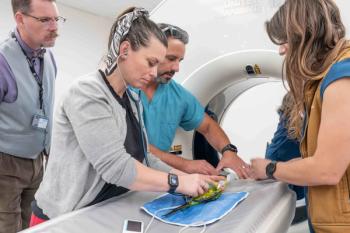
Feline biliary challenges (Proceedings)
Biliary diseases in cats can be complex and challenging to diagnose.
Biliary diseases in cats can be complex and challenging to diagnose. Some of these disorders include congenital biliary dysplasia (Caroli-like syndrome), cholecystitis, choledochitis, cholelithiasis, hepatobiliary cysts, hepatobiliary neoplasia, and extra-hepatic biliary obstruction (EHBO). EHBO will be extensively discussed in this presentation.
EHBO is uncommon in cats, and its underlying causes are often unknown. The most common reported causes of EHBO are tumors and inflammation of the common bile duct, pancreas or duodenum, and choledocholithiasis. The common clinical signs are non-specific and include: decreased appetite, anorexia, lethargy and vomiting.
A common bile duct diameter larger than 5 mm is a useful feature supporting EHBO in cats. However gallbladder dilation is not a reliable sign of EHBO as it is encountered in less than 50% of cats. Dilation of intrahepatic and/or extrahepatic ducts along with the common bile duct may improve the detection of biliary obstruction. Extrahepatic and intrahepatic ducts are usually not visible ultrasonographically in normal cats.
In one study, 90% of the cats had dilated intrahepatic and/or extrahepatic ducts, indicating that this sign is an important ultrasonographic feature of EHBO in cats. Dilation of intrahepatic and/or extrahepatic ducts is not a pathognomonic sign of extrahepatic biliary obstruction as it can associated with non obstructive hepatobiliary diseases; therefore these findings should always be interpreted in the light of clinical and biologic changes as well as other ultrasonographic findings that might be suggestive of EHBO.
Obstructive choledocholithiasis can reliably be diagnosed; mineralized and non mineralized choleliths can be distinguished based on their ultrasonographic features. Most obstructive choleliths are located in the distal common bile duct close to or into the duodenal papilla.
In absence of obstructive cholelith, it is often not possible to accurately differentiate an inflammatory disease from a tumor, as size, shape, echogenicity and location of the masses can be similar in the two groups.
In infiltrative liver diseases, ultrasonography has a limited sensibility in reliably detecting changes in echogenicity and echotexture.
Pancreatic diseases (as cause of EHBO) can be sometimes diagnosed using ultrasound however; there is no reliable ultrasonographic features allowing final discrimination between pancreatic tumor and pancreatitis.
Ultrasonographic features of biliary tract diseases should be interpreted along with the duration of clinical signs. A shorter duration of clinical signs in the obstructive cholelithiasis in comparison to the inflammation or tumor groups has been reported. It is speculated that a cholelith is more prone than inflammation and neoplasia to induce an acute/subacute complete obstruction of the biliary tree as it occludes the biliary lumen. Longer duration of clinical signs with inflammatory and neoplastic diseases might be secondary to a progressive obliteration of the biliary lumen.
References
Bacon NJ, White RAS. Extrahepatic biliary tract surgery in the cat: a case series and review. J Small Anim Pract 2003;44:231-235.
Buotte NJ, Mitchell SL, Penninck D, Freeman LM, Webster CRL. Cholecystoenterostomy for treatment of extrahepatic biliary tract obstruction in cats : 22 cases (1994-2003). J Am Vet Med Assoc 2006;228:1-7.
Center SA, Baldwin BH, King JM, Tennant BC. Hematologic and biochemical abnormalities associated with induced extrahepatic bile duct obstruction in the cat. Am J Vet Res, 1983;44:1822-1829.
Gaillot HA, Penninck DG, Webster CRL, Crawford S. Ultrasonographic features of extrahepatic biliary obstruction in 30 cats. Vet Radiol & US 2007;48:439-447.
Hittmair KM, Vielgrader HD, Loupal G. Ultrasonographic evaluation of gallbladder wall thickness in cats. Vet Radiol Ultrasound 2001;42:149-155.
Léveillé R, Biller DS, Shiroma JT. Sonographic evaluation of the common bile duct in cats. J Vet Int Med 1996;5:296-299.
Mayhew PD, McLear RC, Washabau RJ. Pathogenesis and outcome of extrahepatic biliary obstruction in cats. J Small Anim Pract 2002;43:247-253.
Newsletter
From exam room tips to practice management insights, get trusted veterinary news delivered straight to your inbox—subscribe to dvm360.






